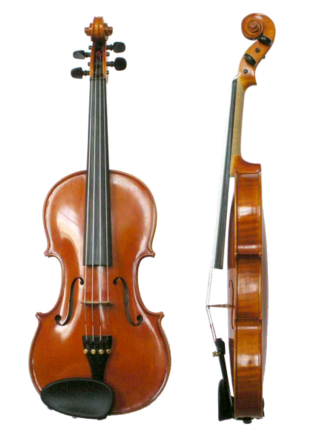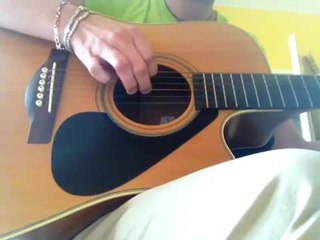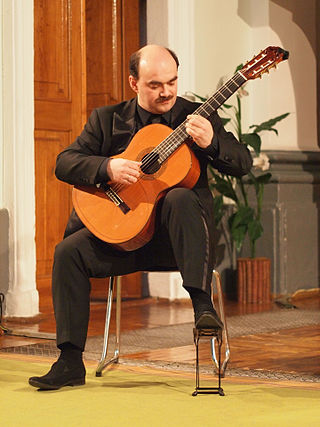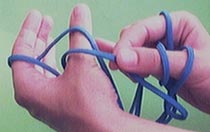
The violin, colloquially known as a fiddle, is a wooden chordophone, and is the smallest, and thus highest-pitched instrument (soprano) in regular use in the violin family. Smaller violin-type instruments exist, including the violino piccolo and the pochette, but these are virtually unused. Most violins have a hollow wooden body, and commonly have four strings, usually tuned in perfect fifths with notes G3, D4, A4, E5, and are most commonly played by drawing a bow across the strings. The violin can also be played by plucking the strings with the fingers (pizzicato) and, in specialized cases, by striking the strings with the wooden side of the bow.

Slapping and popping are ways to produce percussive sounds on a stringed instrument. They are primarily used on the double bass or bass guitar. Slapping on bass guitar involves using the edge of one's knuckle, where it is particularly bony, to quickly strike the string against the fretboard. On bass guitars, this is commonly done with the thumb, while on double bass, the edge of the hand or index finger may be used. Popping refers to pulling the string away from the fretboard and quickly releasing it so it snaps back against the fretboard. On bass guitar, the two techniques are commonly used together in alternation, though either may be used separately.

Cat's cradle is a game involving the creation of various string figures between the fingers, either individually or by passing a loop of string back and forth between two or more players. The true origin of the name is debated, though the first known reference is in The light of nature pursued by Abraham Tucker in 1768. The type of string, the specific figures, their order, and the names of the figures vary. Independent versions of this game have been found in indigenous cultures throughout the world, including in Africa, Eastern Asia, the Pacific Islands, Australia, the Americas, and the Arctic.

Fingerstyle guitar is the technique of playing the guitar or bass guitar by plucking the strings directly with the fingertips, fingernails, or picks attached to fingers, as opposed to flatpicking. The term "fingerstyle" is something of a misnomer, since it is present in several different genres and styles of music—but mostly, because it involves a completely different technique, not just a "style" of playing, especially for the guitarist's picking/plucking hand. The term is often used synonymously with fingerpicking except in classical guitar circles, although fingerpicking can also refer to a specific tradition of folk, blues and country guitar playing in the US. The terms "fingerstyle" and "fingerpicking" are also applied to similar string instruments such as the banjo.

Caroline Augusta Jayne was an American ethnologist who published the first book on string figures in 1906 titled String Figures: A Study of Cat's Cradle in Many Lands.

Hybrid picking is a guitar-playing technique that involves picking with a pick (plectrum) and one or more fingers alternately or simultaneously. Hybrid picking allows guitar players who use a pick to perform music which would normally require fingerstyle playing. It also facilitates wide string leaps which might otherwise be quite difficult. The technique is not widespread in most genres of guitar playing, but is most often employed in "chicken pickin'"; rockabilly, country, honky-tonk, and bluegrass flatpicking styles who play music which occasionally demands fingerstyle passages.
Hybrid picking involves playing with the pick and the right hand m and/or a fingers...at the same time. The pick is held in the usual way...and the fingers execute free strokes in the typical fingerstyle manner...Hybrid picking allows fingerstyle-like passages to be freely interspersed with flatpicked passages...without any delay.
In music, fingering, or on stringed instruments sometimes also called stopping, is the choice of which fingers and hand positions to use when playing certain musical instruments. Fingering typically changes throughout a piece; the challenge of choosing good fingering for a piece is to make the hand movements as comfortable as possible without changing hand position too often. A fingering can be the result of the working process of the composer, who puts it into the manuscript, an editor, who adds it into the printed score, or the performer, who puts his or her own fingering in the score or in performance.
Fingering...also stopping...(1) A system of symbols for the fingers of the hand used to associate specific notes with specific fingers....(2)Control of finger movements and position to achieve physiological efficiency, acoustical accuracy [frequency and amplitude] and musical articulation.

Alfred Cort Haddon, Sc.D., FRS, FRGS FRAI was an influential British anthropologist and ethnologist. Initially a biologist, who achieved his most notable fieldwork, with W.H.R. Rivers, C.G. Seligman and Sidney Ray on the Torres Strait Islands. He returned to Christ's College, Cambridge, where he had been an undergraduate, and effectively founded the School of Anthropology. Haddon was a major influence on the work of the American ethnologist Caroline Furness Jayne.

In classical guitar, the right hand is developed in such a way that it can sustain two, three, and four voice harmonies while also paying special attention to tone production. The index (i), middle (m), and ring (a) fingers are generally used to play the melody, while the thumb (p) accompanies in the bass register adding harmony and produces a comparable texture and effect to that of the piano. The classical guitar is a solo polyphonic instrument, and it is difficult to master.
The International String Figure Association is not-for-profit organization for the preservation, dissemination, and creation of string figures. The association was founded in Japan in 1978 by mathematician Hiroshi Noguchi and Anglican missionary Philip Noble, and is now run by Mark Sherman out of California. Members have included Honor Maude. ISFA publishes the Bulletin of the International String Figure Association annually, ISFA News semi-annually, and String Figure Magazine quarterly.
Australian Aboriginal fibrecraft refers to the various ways Aboriginal Australians create fibres traditionally. Materials used depend on where the people live in Australia.

Guitar picking is a group of hand and finger techniques a guitarist uses to set guitar strings in motion to produce audible notes. These techniques involve plucking, strumming, brushing, etc. Picking can be done with:

In music performance and education, thumb position, not a traditional position, is a string instrument playing technique used to facilitate playing in the upper register of the double bass, cello, and related instruments, such as the electric upright bass. To play passages in this register, the player shifts their hand out from behind the neck and curves the hand, using the side of the thumb to press down the string; in effect, the side of the thumb becomes a movable nut (capo).
Honor Courtney Maude was a British-Australian authority on Oceanic string figures, having published Maude & Maude 1958, Maude & Wedgewood 1967, Firth & Maude 1970, Maude 1971, Maude 1978, Emory & Maude 1979, Maude 1984, and Beaglehole & Maude 1989. Maude was a charter member of the International String Figure Association in 1978.
Camilla Gryski is a Canadian librarian and string figure enthusiast. She has a degree in English, an M.L.S., an M.Ed, and a Montessori Primary Teaching Certificate. She worked in Toronto's Hospital for Sick Children as a Therapeutic Clown.
Julia Pavlovna Petrova-Averkieva was a Soviet anthropologist and string figure collector. A student of Franz Boas, and influenced by Lewis Henry Morgan, she went on to serve as the director of North American Studies at the Institute of Ethnography in Moscow. She compiled the a collection of Kwakwakaʼwakw string figures, which is recognized as "the most comprehensive Native American string figure collection ever assembled from a single tribe [or nation]."
Mark Allen Sherman of Pasadena, California is a biochemist (PhD) and prominent string figure enthusiast. His editing and writing led to the publishing of Kwakiutl String Figures by Julia Averkieva, "the most comprehensive Native American string figure collection ever assembled from a single tribe," the Kwakwaka'wakw. He founded ISFA Press in 1993, co-edited and illustrated String Figure Magazine from 1996 to 2005, and has been editor of the Bulletin of the International String Figure Association, which he founded, since 1994.
Kathleen Haddon Rishbeth was a British zoologist, photographer and collector of string figures. She was the wife of Australian geographer Oswald Rishbeth.

















